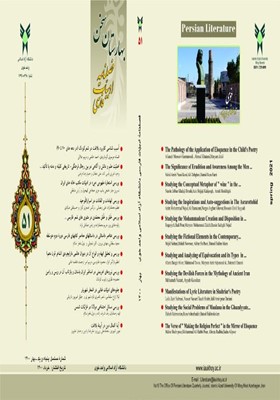Studying the Devilish Forces in the Mythology of Ancient Iran and its Reflection in the Wayce and Ramin
Subject Areas : Abstract ArticlesMa'sumeh Nazari 1 , Ayyub Kooshan 2
1 - PhD in Persian Language and Literature and lecturer at Siraj Tabriz Non-Profit Institute, Iran
2 - Department of Persian Language and Literature, Tabriz Branch, Islamic Azad University, Tabriz, Iran.
Keywords: demon, Devil, Fairy, The Avesta, Keywords: Zoroastrianism, Wayce and Ramin,
Abstract :
Abstract Belief in dualism and the opposition of goodness and badness can be seen in the nature, human being and the contrasting forces in the world and in the mythology of ethnics including Indo-European and Aryan tribes. In Zoroastrianism, Ahura Mazda is the omnipotent of goodness , and Ahriman ( devil ) stands at the top of satanic forces.Belief in this dualism, in the mythological and epic works indicates the tenet of mythological man in the division of the world into two areas of goodness and badness. It has been tried, in this paper, to study the satanic forces in the ancient mythology of Iran and its reflection in " The Wayce and Ramin " and answer the question whether these creatures have the signs of satanic manner in the Avesta or not, and have they maintained their self-innovence. The study method is descriptive-analytic. One can conclude from the results that satanic creatures in the wayce and Ramin are adaptable with giant demons in the Avesta and Pahlavi texts; sometimes they are real beings which, with concrete picture are able to function in the mythological world. In this paper, besides the demons posed in the Iranian ancient culture, we've discussed about the other two demons of kindness and destruction.
فهرست منابع و مآخذ
2- اسعدگرگانی، فخرالدّین، (1337)، ویس و رامین، تصحیح محمّدجعفر محجوب، تهران: بنگاه اندیشه.
_||_


